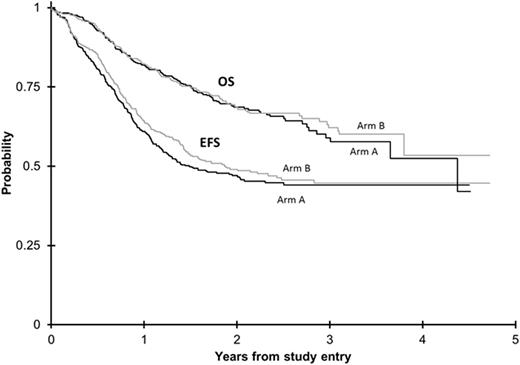Abstract

Introduction:
Despite the very high intensity of current chemotherapy regimens for children with acute myeloid leukemia (AML), approximately 50% of patients will experience disease relapse. New therapeutic strategies to improve clinical outcomes have centered on improving the efficacy of standard chemotherapy with novel agents such as gemtuzumab and other agents designed to augment standard chemotherapy. Bortezomib, a proteasome inhibitor, is one such agent. The Children's Oncology Group (COG) Phase III clinical trial AAML1031 tested the hypothesis that the addition of bortezomib to standard chemotherapy would improve treatment outcomes in pediatric patients with newly diagnosed AML.
Methods:
The COG AAML1031 trial randomized patients younger than 30 years of age with de novo AML to either standard chemotherapy (Arm A) or standard chemotherapy with bortezomib (Arm B). Patients with high allelic ratio FLT3 ITD were offered enrollment on a standard chemotherapy plus sorafenib (Arm C, n = 102) and are excluded from this efficacy analysis. All patients received induction chemotherapy with cytarabine, daunorubicin, and etoposide (ADE). Risk stratification occurred at the end of ADE induction and was based on the presence of high risk cytogenetic/molecular markers and/or minimal residual disease (MRD) >0.1% determined by multidimensional flow cytometry. Low risk patients received three additional courses of chemotherapy consisting of a second course of ADE, a third course of cytarabine/etoposide and a fourth course of cytarabine/mitoxantrone. High risk patients received a second course of cytarabine/mitoxantrone, a third course of cytarabine/etoposide, and then allogeneic stem cell transplant (SCT) from the best available donor. Bortezomib 1.3 mg/m2 was given on days 1, 4 and 8 of each cycle with one dose de-escalation to 1 mg/m2 allowed for dose limiting toxicity.
Results:
A total of 1097 patients were randomized to either standard therapy (Arm A, n = 542) or standard chemotherapy with bortezomib (Arm B, n = 555). No statistically significant differences in sex, age, race, ethnicity, WHO classification, initial blast count, or initial CNS status was observed between arms. Remission induction rate did not differ between treatment arms 89% vs 91%, p = 0.457. MRD was negative in 75% of patients on both treatment arms at the end of Induction I and mean MRD measures did not differ significantly: 2.8% vs 1.9%, p = 0.247. For all patients, event free survival (EFS) and overall survival (OS) at 3 years were 44.4% ± 3.8% and 60.6% ± 4.4%. EFS was not significantly different between Arms A and B (44.0% ± 5.2% vs 44.6% ± 5.6%, p = 0.285) (Figure 1). Likewise, OS was similar between arms (59.0 ± 6.7 vs 62.2 ± 6.0, p = 0.732) (Figure 1). One year cumulative treatment related mortality (TRM) was 14.6 ± 9.3 and 10.8 ± 7.5, p = 0.49 for Arms A and B, respectively. No significant differences were seen in OS, disease-free survival, and TRM from the end of Induction I in low and high risk groups. Cox proportional hazards analysis demonstrated that initial WBC count at diagnosis was the only consistently identified risk factor for OS, DFS, and TRM. Targeted toxicity monitoring identified increased toxicity risks in Arm B for peripheral neuropathy (Induction I/II), dose reductions (all chemotherapy courses), and PICU admissions (Induction I/II) and Intensification I). Serial monitoring of cardiac ejection fraction/shortening fraction in all patients did not demonstrate a clinically meaningful difference in drop in ejection fraction/shortening fraction by treatment arm. No other consistent differences in targeted toxicity rates were identified.
Conclusions:
The addition of bortezomib to standard chemotherapy increased toxicity but did not improve EFS or OS in children with newly diagnosedAML Consequently, bortezomib should not be used in children with de novo AML in combination with standard chemotherapy. Future work will evaluate the role of intensifying Induction II therapy for patients with high risk AML, further refine risk stratification, and define a more optimal role for allogeneic donor SCT in pediatric AML.
Loken:Hematologics: Employment, Equity Ownership.
Author notes
Asterisk with author names denotes non-ASH members.

This icon denotes a clinically relevant abstract


This feature is available to Subscribers Only
Sign In or Create an Account Close Modal